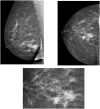Molecular imaging of breast cancer: present and future directions
- PMID: 25566530
- PMCID: PMC4270251
- DOI: 10.3389/fchem.2014.00112
Molecular imaging of breast cancer: present and future directions
Abstract
Medical imaging technologies have undergone explosive growth over the past few decades and now play a central role in clinical oncology. But the truly transformative power of imaging in the clinical management of cancer patients lies ahead. Today, imaging is at a crossroads, with molecularly targeted imaging agents expected to broadly expand the capabilities of conventional anatomical imaging methods. Molecular imaging will allow clinicians to not only see where a tumor is located in the body, but also to visualize the expression and activity of specific molecules (e.g., proteases and protein kinases) and biological processes (e.g., apoptosis, angiogenesis, and metastasis) that influence tumor behavior and/or response to therapy. Breast cancer, the most common cancer among women and a research area where our group is actively involved, is a very heterogeneous disease with diverse patterns of development and response to treatment. Hence, molecular imaging is expected to have a major impact on this type of cancer, leading to important improvements in diagnosis, individualized treatment, and drug development, as well as our understanding of how breast cancer arises.
Keywords: breast cancer; breast cancer diagnosis; breast imaging techniques; breast magnetic resonance imaging; contrast agents; molecular imaging of breast.
Figures
References
-
- Agner S. C., Rosen M. a., englander s., tomaszewski j. e., feldman m. d., zhang p., et al. (2014). computerized image analysis for identifying triple-negative breast cancers and differentiating them from other molecular subtypes of breast cancer on dynamic contrast-enhanced MR images: a feasibility study. Radiology 272, 91–99 10.1148/radiol.14121031 - DOI - PMC - PubMed
-
- Alcantara D., Blois J., Ceacero C. (2010). Editorial. All Results J. Biol. 1, 1–3.
Publication types
LinkOut - more resources
Full Text Sources
Other Literature Sources
Miscellaneous




